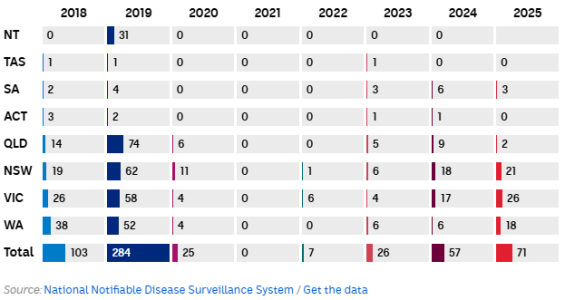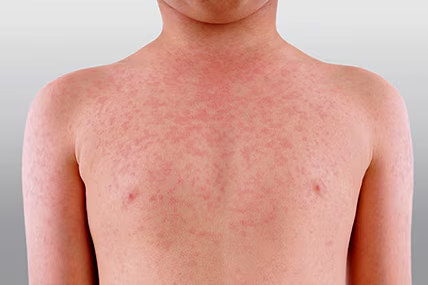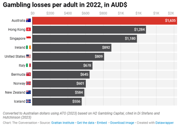Measles cases across the country reach highest levels in six years
By
ABC News
- Replies 0
Measles cases have reached the highest number of infections nationwide in six years.
The National Notifiable Disease Surveillance System shows 71 measles cases have been reported across the country this year so far.
This already exceeds the total for 2024 and is the highest number recorded since 2019, when there were 284 cases.
This year, 14 cases were reported in people aged 25-29 years old, and children aged 0-4 years old had the second highest number of infections recorded.
Measles cases by state 2018-2025
Measle cases across the country have reached a peak not seen since 2018-19.
Health officials have issued a nationwide call to prevent the spread.
Why are we seeing more measles cases?
In April, medical professionals urged travellers to stay vigilant amid a global rise in cases in the United States and other parts of the world.
Ramya Raman, the Royal Australian College of General Practitioners vice-president and Western Australia chair, told the ABC the rise in cases could be because people were travelling overseas more frequently.
The vaccination rate could also be a contributing factor, Dr Raman said.
"We are below the 95 per cent vaccination rate that we need for herd immunity, so overseas arrivals and local infection spreading and the infectiousness of the actual condition is probably all contributing to that," she said.
Unvaccinated and partially vaccinated
The measles virus has not been widely circulating in Australia for some time, largely due to many people already receiving double dose vaccinations, reducing the chances of catching the virus.
Studies suggest that one bout of measles usually results in lifelong immunity
Two doses of the MMR (Mumps, Measles, and Rubella) vaccine was introduced to the national childhood immunisation schedule in the early 90s.
But Australians born before then might have received only one dose and be "partially vaccinated", Dr Raman said.
"If you were born after 1965 and haven't already had two doses of the measles, mumps, and rubella vaccine, you can get up to two free MMR vaccinations through your GP," she said.
What are the symptoms of Measles?
Measles is a highly infectious, itchy rash with a fever, which typically affects children, but medicos are now seeing a spike in older age groups.
People struck down with measles usually have a rash and flu-like symptoms.
It begins with the "prodrome phase" which lasts about two to four days.
A person can experience a fever that exceeds 38 degrees Celsius, as well as a cough, runny nose and conjunctivitis — redness and swelling of the eyes.
"Often, patients look quite unwell during this time as well, and then as the illness progresses, the rash starts," Dr Raman said.
The measles rash usually begins three to five days after the prodrome phase.
The rash is usually red, and raised, and can be flat. It typically starts on the face, around the hairline, and then spreads down into the neck, the trunk, the arms, legs, and feet.
"[The measles rash] is initially spotty, then merges over time to become blotchy patches. And it's always a little bit trickier to see these spots on patients with darker skin tones," Dr Raman said.
Calls for preventive measures
Measles can be a nasty virus, especially for the vulnerable, elderly or immunocompromised.
The Australian Immunisation Handbook recommends vaccination for people born during or since 1966 who have not received the two doses, particularly healthcare workers, childhood educators, and carers.
Dr Raman suggests pregnant women should not get the vaccine but instead speak with their GP.
She said it was important to see a healthcare professional if you suspect you have the measles to prevent its spread.
"This is a highly contagious virus, but it's also important for patients to seek medical attention if they're not feeling quite well."
Written by Zena Chamas, ABC News.
Last edited:










